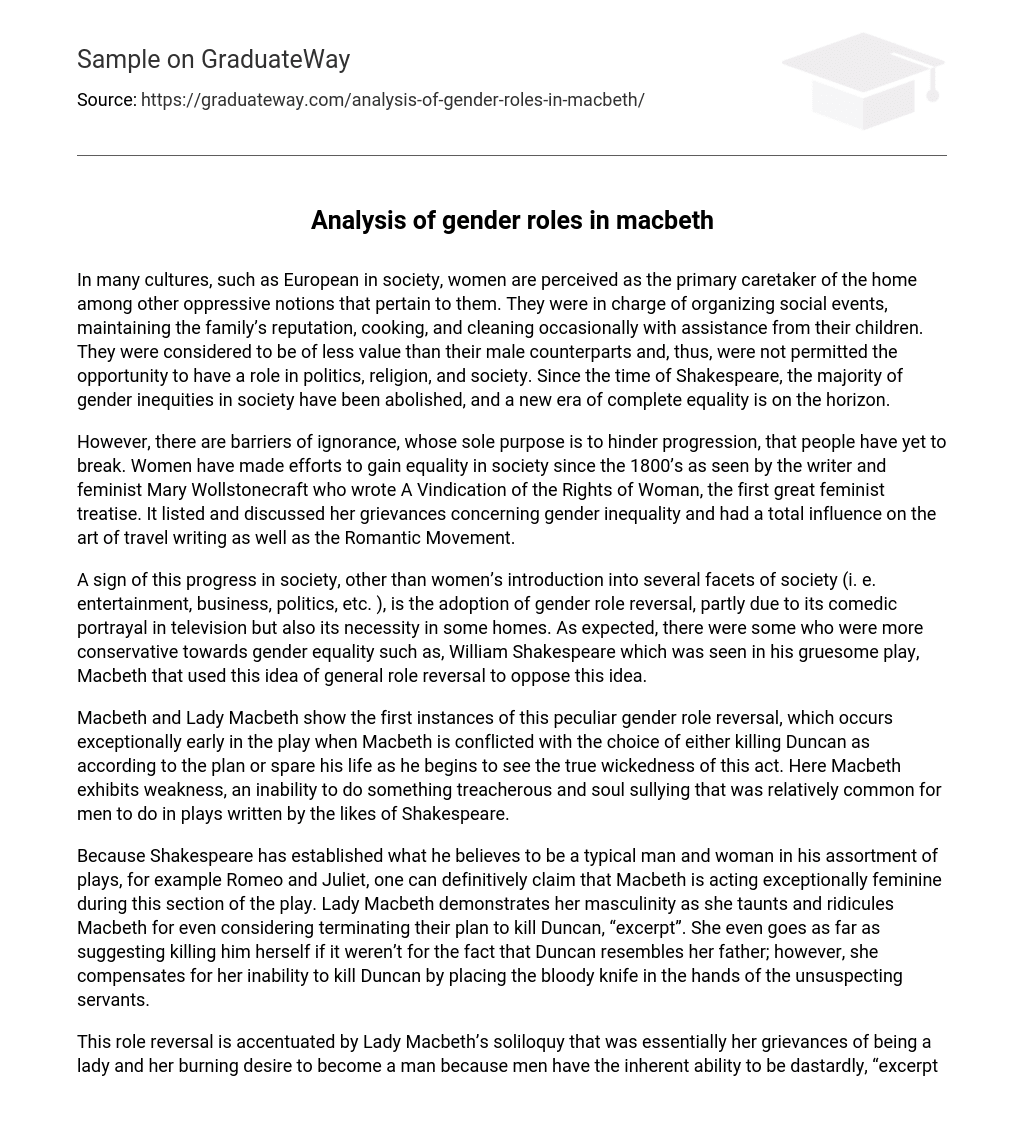Throughout various cultures, especially in European society, women have traditionally held the role of primary caregiver within the household. This role has been accompanied by other restrictive beliefs and expectations placed upon them. Women were tasked with managing social gatherings, maintaining the family’s reputation, cooking, and occasionally receiving assistance from their children for cleaning tasks. Due to societal views that deemed them inferior to men, women were denied participation in politics, religion, and broader society. However, significant progress has been made since Shakespeare’s era in eliminating gender disparities within society. A future characterized by complete equality is now on the horizon.
Throughout history, women have faced barriers of ignorance that hinder their progress. However, they have persistently fought for equality in society. One notable advocate for women’s rights was Mary Wollstonecraft, a writer and feminist during the 1800s. In her influential treatise titled A Vindication of the Rights of Woman, she courageously tackled and examined gender inequality concerns. Furthermore, her work left a profound impact on both travel writing and the Romantic Movement.
One indicator of societal progress is the inclusion of women in various aspects of society, such as entertainment, business, and politics. This progress is also reflected in the adoption of gender role reversal, which has been both comically depicted on television and necessitated in certain households. However, there were individuals, like William Shakespeare, who held more conservative views on gender equality, as demonstrated in his play Macbeth that utilized the concept of general role reversal to challenge this idea.
Macbeth and Lady Macbeth demonstrate an initial occurrence of role reversal in terms of gender in the play. Macbeth finds himself torn between adhering to the plan to murder Duncan or sparing his life, as he begins to grasp the true evilness of this deed. At this point, Macbeth displays vulnerability, a lack of ability to fully commit to a deceitful and morally corrupt act that was frequently anticipated from male characters in Shakespearean plays.
Shakespeare’s portrayal of characters in his plays, including Romeo and Juliet, sets a standard for both genders. In Macbeth, Shakespeare presents behavior that can be perceived as feminine. However, Lady Macbeth exhibits masculinity by mocking Macbeth for doubting their plot to kill Duncan. She even implies that she would personally murder Duncan if he didn’t remind her of her father. Nevertheless, she is unable to carry out the deed and instead tricks the unaware servants by placing the bloodied knife in their possession.
This passage discusses the reversal of traditional gender roles, as seen in Lady Macbeth’s soliloquy. In her speech, she expresses her discontent with her female identity and strongly desires to become a man. Lady Macbeth believes that men inherently possess evil characteristics, which she also wishes to possess. While her reasons for wanting to be “unsexed” are not completely admirable, Shakespeare openly reveals his misogynistic beliefs by suggesting that women can only achieve equal intellectual abilities as men by physically transforming into men. This transformation could happen either through childbirth or symbolically replacing breast milk with gall.
Despite the play containing subtle sexism, Shakespeare emphasizes traditional gender roles throughout. However, it is in the final stages of the play that the true message becomes evident. Lady Macbeth’s descent into madness due to guilt leads her to take her own life, while Macbeth meets his tragic demise through decapitation. Consequently, Macbeth serves as a cautionary tale comparable to an extended Direct T.V. advertisement: reversing gender roles may result in descending into madness, leading to institutionalization and ultimately suicide. The audience is cautioned against engaging in such a grave action.
Stay with tradition, or heed a 17th century public service announcement that warns of the consequences when a man and a woman imitate Macbeth and Lady Macbeth. Shakespeare clearly supports traditional gender roles, but the troubling aspect is in how he expresses this belief. The graphic and shocking consequences of Lady Macbeth taking on a masculine role and Macbeth unintentionally displaying femininity serve to convey a straightforward message, but the intensity of this portrayal leaves room for multiple interpretations.
One reason for the integration of gender role reversal in Shakespeare’s plays is the prevalence of suicide, murder, and death. This combination, coupled with his writing style, creates a nightmare for feminists. Although Shakespeare may have intended a modest incorporation of this idea, it was perceived differently by the audience. Another reason is that the catastrophic endings were not accidental, but rather designed to instill fear and discourage any attempts to challenge traditional norms.
Macbeth and Lady Macbeth’s downfall resulted from their refusal to conform. Consequently, those who follow in their footsteps can expect similar consequences. Ultimately, the play conveys the message that disturbing the fundamental order of humanity inevitably leads to chaos, making Macbeth a cautionary tale for women who defy the system in their pursuit of rights. Nevertheless, some fail to recognize the glaring sexism and dismiss any interpretation suggesting otherwise.





